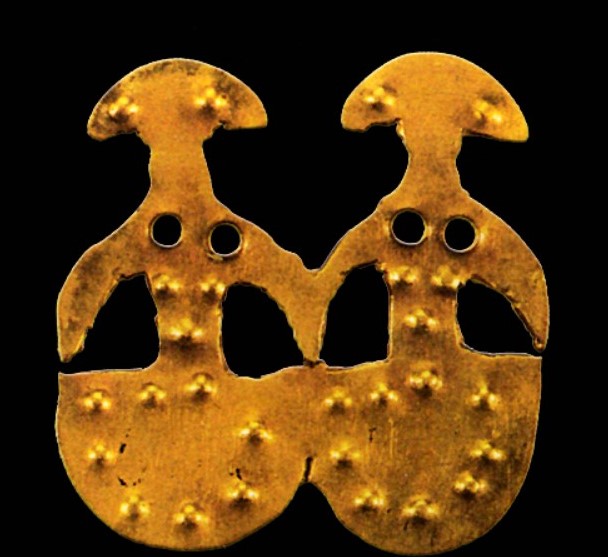Alaca Höyük Tombs of the Early Bronze Age and Twin Idols
Aykut ÇINAROĞLU
Abstract
The metal artifacts found in the King’s tombs of the Early Bronze Age at Alaca Höyük constitute one of the most important work groups within Near East archeology finds. We don’t know the identities of those buried in these tombs, which we can accept as members of a dynasty in Alaca Höyük during the Early Bronze Age III period. Because the writing hasn’t been used yet in this period. However, Alaca Höyük is a strong and rich center of a small kingdom, and the tombs belong to family members who have a local authority and belong to them. For this reason it is obvious that the graves belong to an elite group. In this article, a review of these objects and a period of time were made in the archaeological literature which is thought to be a furniture ornament found in the dead gifts of the elitist section buried in the graves, which are referred to as twin idols.
|
Arık 1937a |
R. O. Arık, “Türk Tarih Kurumu Tarafından Yapılan Alaca Höyük Hafriyatı: 1935’deki çalışmalara ve keşiflere ait ilk rapor”, Türk Tarih Kurumu Yayınları V-1, Ankara, 1937. |
|
Arık 1937b |
R. O. Arık, “Alaca Höyük Hafriyatı’nın İlk Neticeleri”, Belleten 1.1 (1937), 210-221. |
|
Bailey 2005 |
D. W. Bailey, Prehistoric Figurines: Representation and Corporeality in the Neolithic, London, 2005. |
|
Baltacıoğlu 2002 |
H. Baltacıoğlu, “Arkeolojik ve Antropolojik Verilerin Işığından Alaca Höyük Kral Mezarları Konusunda Gözlemler”, Ed: N. Ş. Doğan. Orta Çağ’da Anadolu, Prof. Dr. Aynur Durukan’a Armağan, Ankara, 2002, 91-112. |
|
Becker 2010 |
V. Becker, “Anthropomorphe Plastiken Westbulgariens und ihre Stellung im südosteuropäischen Neolithikum”, Studia Praehistorica 13 (2010), 23-40. |
|
Bilgi 2012 |
Ö. Bilgi, Anadolu’da İnsan Görüntüleri: Klasik Çağ Öncesi, İstanbul, 2012. |
|
Bittel 1982 |
K. Bittel, Atatürk, Mustafa Kemal Atatürk, 1881-1981 vorträge und Aufsätze zu seinem 100. Geburtstag, Heidelberg, 1938. |
|
Chantre 1898 |
E. Chantre, Recherches archéologiques dans l’Asie occidentale. Mission en Cappadoce, Paris, 1898. |
|
Chernykh 2011 |
E. N. Chernykh, “Eurasian Steppe Belt. Radiocarbon Chronology and Metallurgical Provinces”, Ed: Ü. Yalçın. Anatolian Metal V, Der Anschnitt, Beiheft 24 (2011), 151-171. |
|
Çınaroğlu – Çelik 2010 |
A. Çınaroğlu – D. Çelik, Atatürk ve Alaca Höyük, Ankara, 2010 |
|
Çınaroğlu –Çelik 2011 |
A. Çınaroğlu – D. Çelik, “2009 Yılı Alaca Höyük Kazıları”, 32. Kazı Sonuçları Toplantısı 4.Cilt (2011), 183-193. |
|
Güterbock 1938 |
H. G. Güterbock, “Die Tradition und Ihre Literarische Gestaltung bei Babyloniern und Hethitern bis 1200. Zweiter Teil: Hethiter”, Zeitschrift für Assyriologie und vorderasiatische Archäologie 44 (1938), 45-149. |
|
Hamilton 1842 |
W. J. Hamilton, Researhces in Asia Minor, Pontus and Armenia: With some account of their antiquities and geology, London, 1842. |
|
Joukowsky 1996 |
M. S. Joukowsky, Early Turkey: An Introduction to the Archaeology of Anatolia from Prehistoric Through the Lydian Period, Iowa, 1996. |
|
Kansu 1937 |
Ş. A. Kansu, “Alacahöyük’te Bulunan İskeletlerin Antropolojik Tetkiki”, Belleten 1-1 (1937), 180-191. |
|
Koşay – Akok 1966 |
H. Z. Koşay – M. Akok, Türk Tarih Kurumu Tarafından Yapılan Alaca Höyük Kazısı: 1940-1948’deki çalışmalara ve keşiflere ait ilk rapor, Türk Tarih Kurumu Yayınları V-6, Ankara, 1966. |
|
Koşay 1938 |
H. Z. Koşay, Türk Tarih Kurumu Tarafından Yapılan Alaca Höyük Hafriyatı: 1936’daki çalışmalara ve keşiflere ait ilk rapor, Türk Tarih Kurumu Yayınları V-2, Ankara, 1938. |
|
Koşay 1951 |
H. Z. Koşay, Türk Tarih Kurumu Tarafından Yapılan Alaca Höyük Hafriyatı: 1937-1939’daki çalışmalara ve keşiflere ait ilk rapor, Türk Tarih Kurumu Yayınları V-6, Ankara, 1951. |
|
Macridy 1908 |
Th. Macridy, “La porte des Sphinx à Euyuk. Fouilles du Musée İmpérial Ottoman”, Mitteilungen der Vorderasiatischen Gesellschaft 13, Berlin, 1908, 1-29. |
|
Makowski 2005 |
M. Makowski, “Anthropomorphic Figurines of Early Bronze Age Anatolia”, Archaeologia 56 (2005), 7-30. |
|
Naumann 1971 |
R. Naumann, Architektur Kleinasiens von ihren Anfängen bis zum Ende der hethitischen Zeit, Wasmuth, 1971. |
|
Özgüç 1948 |
T. Özgüç, Ön Tarihte Anadolu’da Ölü Gömme Adetleri, Ankara, 1948. |
|
Özgüç 2002 |
T. Özgüç, “Eski Tunç Çağı: Hitit Kültürünün Kaynağı Olarak Hatti Kültürü”, Ed: W. Jacob. Hititler ve Hitit İmparatorluğu, 1000 Tanrılı Halk, Bonn, 2002, 400-401. |
|
Özyar 1999 |
A. Özyar, “Reconsidering the “Royal” Tombs of Alacahöyük: Problem of Stratigraphy According to the Topographical Location of the Tombs”, TÜBA-AR II (1999), 79-85. |
|
Perrot – Chipiez 1890 |
G. Perrot – C. Chipiez, History of Art in Sardinia, Judea and Asia Minor, London, 1890. |
|
Şahoğlu 2005 |
V. Şahoğlu, “The Anatolian Trade Network and the Izmir Region during the Early Bronze Age”, Oxford Journal of Archaeology 24.4 (2005), 339-361. |
|
Turan 2007 |
T. Efe, “The Theories of the ‘Great Caravan Route’ between Cilicia and Troy: The Early Bronze Age III. Period in Inland Western Anatolia”, Anatolian Studies 57 (2007), 47-64. |
|
von der Osten 1929 |
H. H. von der Osten, Researches in Anatolia 1: Exploration in Central Anatolia, Season of 1926, Chicago, 1929. |
|
Wiggermann 1998 |
F. A. M. Wiggermann, “Nackte Göttin”, Ed: D. O. Edzard. Reallexikon der Assyriologie und Vorderasiatischen Archäologie vol. 9, Berlin, 1998, 46-53. |
|
Yalçın -Yalçın 2013 |
Ü. Yalçın, H. G Yalçın, “Reassessing Anthropomorphic Metal Figurines of Alaca Höyük, Anatolia”, Near Eastern Archaeology 76/1 (2013), 38-49. |
|
Yiğit 2000 |
T. Yiğit, “Akkadlar Devrinde Anadolu’nun Siyasal Yapısı”. Ankara Üniversitesi Dil ve Tarih-Coğrafya Fakültesi Dergisi 40.3-4 (2000), 13-28. |
|
Yiğit 2003 |
T. Yiğit, “İlk Tunç Çağı’nın Son Evresinde Anadolu’nun Siyasal Görünümü”, Tarih Araştırmaları Dergisi 33 (2003), 167-182. |
A. Çınaroğlu, “Alaca Höyük Erken Tunç Çağı Krali Mezarları ve İkiz İdoller”, Arkhaia Anatolika 1 (2018), 1-14. DOI: 10.32949/Arkhaia.2018.0



